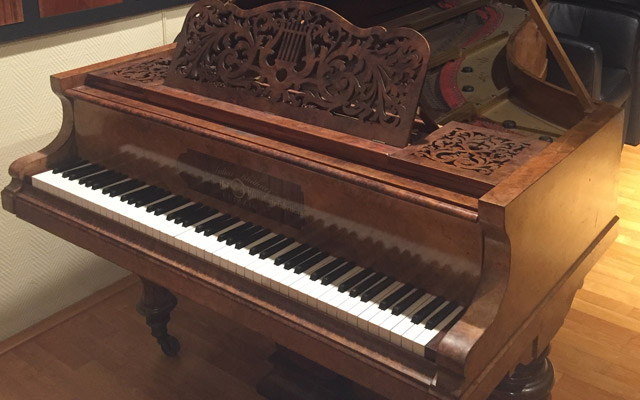On Air Now
Calm Classics with Ritula Shah 10pm - 1am
16 January 2018, 11:33
In the 19th century, Leipzig in Germany had over 200 piano manufacturers – yet Liszt, Wagner, Mahler and Debussy all chose to play and compose on Blüthner pianos. So, what makes these pianos so special?
For over 100 years, pianists and composers have had an extensive choice of instruments at their disposal. But during the 19th century, Prokofiev, Shostakovich, Bruckner, Mahler, Grieg, Dvorák, Debussy, Ravel, Wagner, Rachmaninov and Liszt (to name just a handful) all chose to compose their music on Blüthner pianos.
We visited their piano factory in Leipzig and spoke to Christian Blüthner, to find out what makes a Blüthner a Blüthner.
Blüthner pianos are famous for their clarity and their warm, rich sound. “They create a dark, chocolate sound with a sparkling treble,” Christian says, “without being sharp and metallic. They have a singing element to them.”
For Christian Blüthner, choosing a piano is a very personal experience, so falling in love with the sound of the instrument is crucial.
“You need to have an inspiring moment when you play that piano, and it talks back to you,” he says.
 Franz Liszt’s Blüthner piano
Franz Liszt’s Blüthner piano
The bass notes of the piano need to have a dark clarity to them, Christian explains, which doesn’t overpower the middle and upper sections. After all, the middle of the piano is where the melody is usually played.
“A piano needs to be well-balanced,” he muses, “like a choir that has been put together from so many different voices, then brought together in one big piece.”
As a business which has been family-run since the 19th century, longevity is crucial to the Blüthner company. Their instruments are made to last for generations, and the Blüthner family has stuck to the same traditions since the company was founded over 160 years ago.
Christian, who runs the business with his brother, believes that when you buy a piano, it should be an instrument for life.
Inside a Blüthner piano, the strings that are single-hitched, rather than looped. Each string is hitched on a pin, which leads directly onto individual tuning pins by the keys.
“Blüthner pianos also have an additional string in the treble,” Christian explains, “which resonates in harmony with the main notes, adding overtones and colours which modulate on the soundboard.”
 Edvard Grieg’s Blüthner piano
Edvard Grieg’s Blüthner piano
A piano would be nothing without a great soundboard, as it acts as an amplifier. So, if you play a tune on the keys, the soundboard responds to the vibrations and intensifies the sound.
“Blüthner soundboards are made of well-seasoned spruce wood from the Alps. The trees are carefully cut and well-seasoned over 10 years. The trees are then sawn into quarters, then the best planks are selected and made into a board.
“The board is shaped into a cylindrical crown – not a spherical crown. This design concept is unique in the piano industry, and it makes Blüthner pianos very stable in tuning.”
Of course it’s important that the keys, strings and hammers are made of the highest quality. But as Christian says, “it’s the soundboard that makes the music visible for our ears.”
Here’s jazz pianist Chris Chalmers, playing the beautiful ‘Misty’ on a Blüthner grand piano, Model 4: